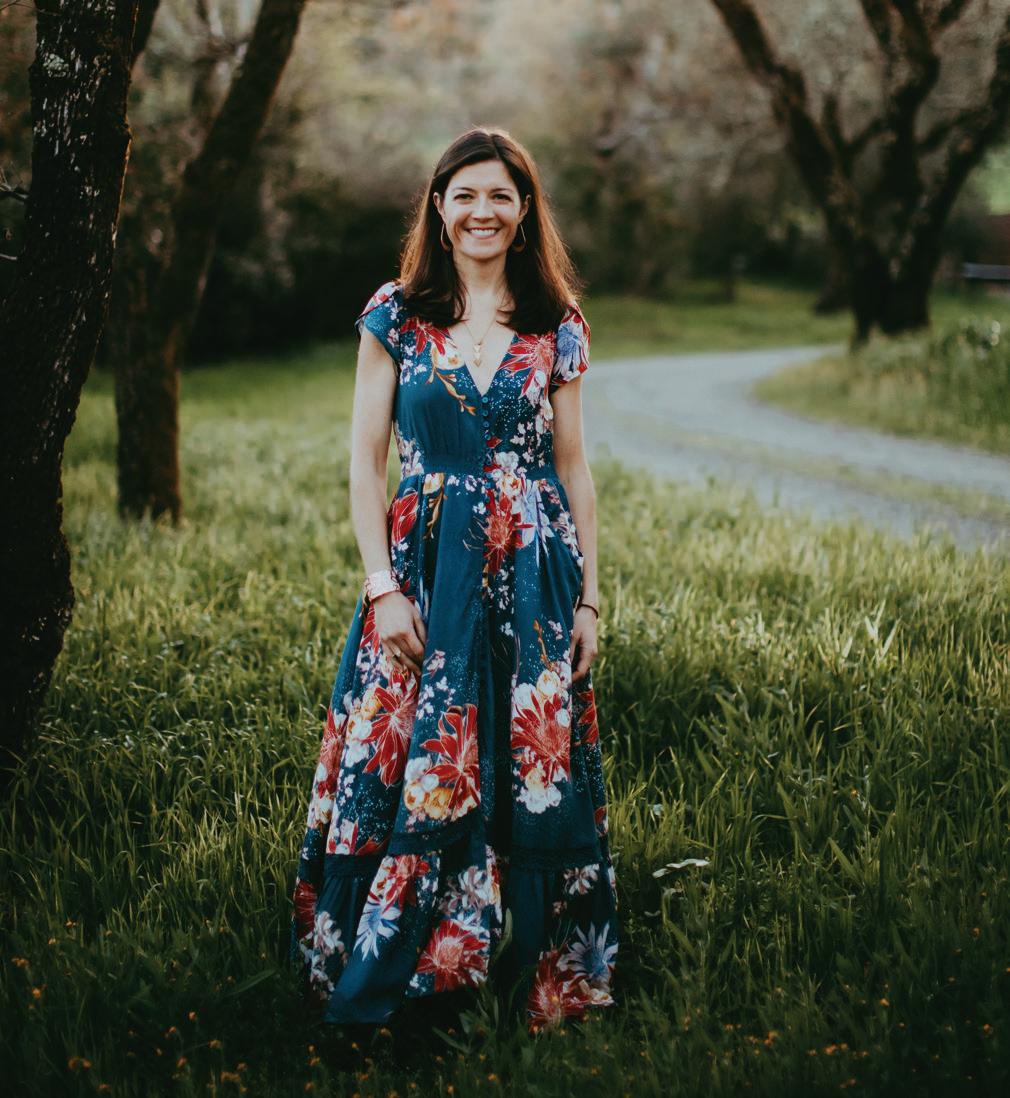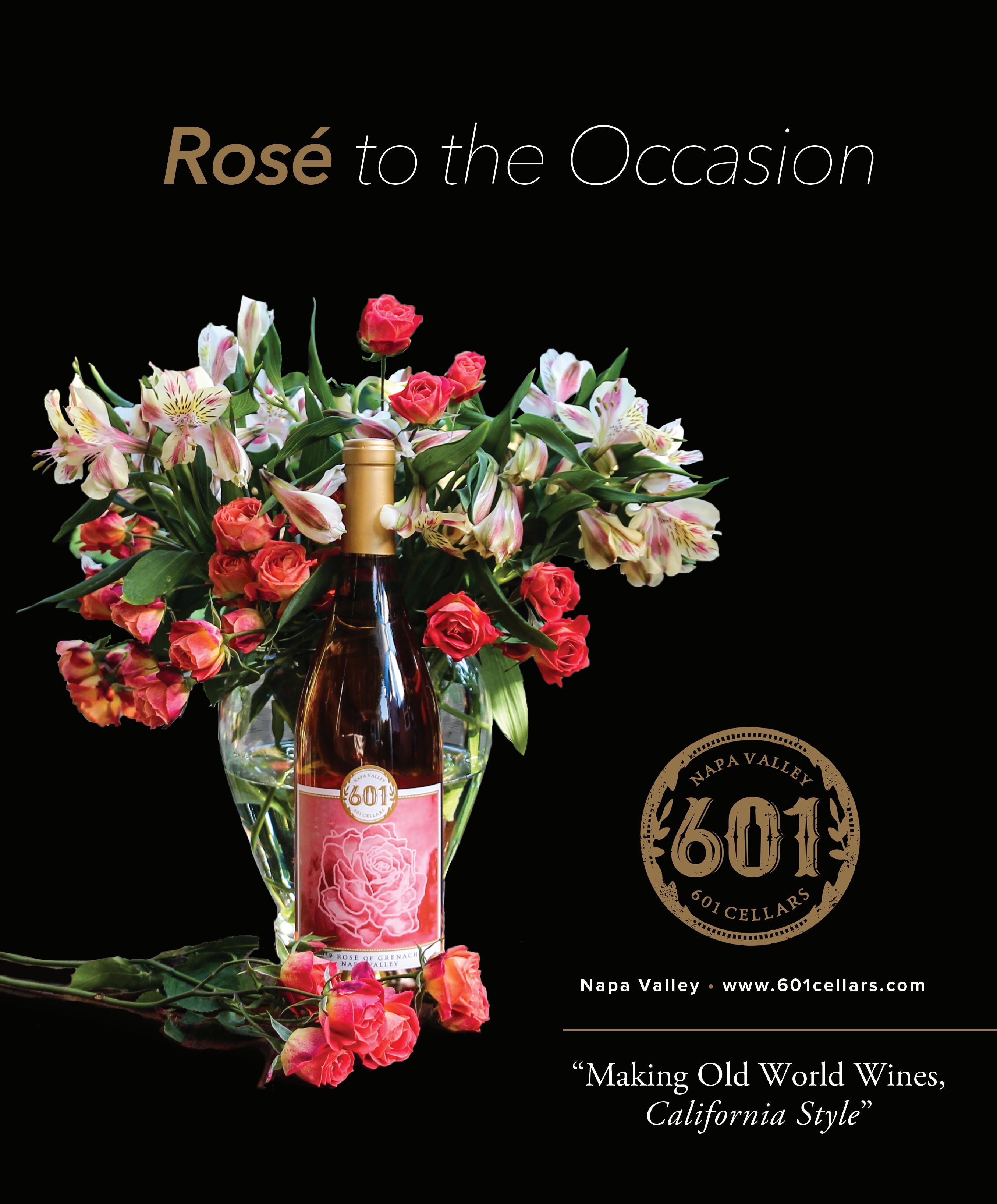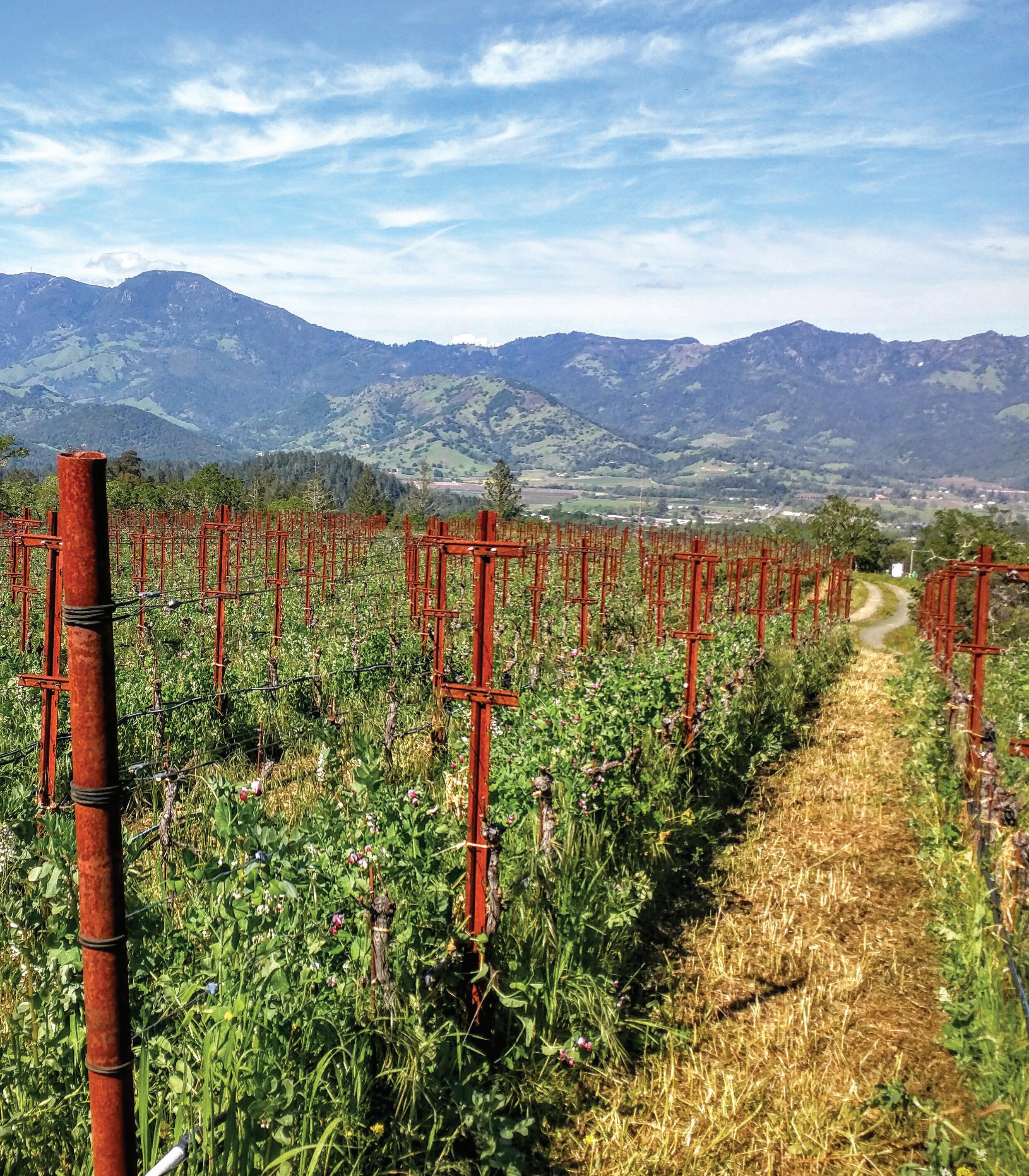
9 minute read
Elan Fayard: Azur
MINDFUL WINEMAKING:
Elan Fayard Finds Her Calling

Photos courtesy of Azur Wines
BY FRAN MILLER
To be known for one perfect wine might be enough for most vintners. But for Elan Fayard, her acclaimed Azur Rosé is just one of many triumphs, both vinous and personal. The Provencal style dry rosé might have placed the Sonoma native and Francophile on the wine country map, but passion, artistry, and a deep connection to terroir and community fuel a life that is as much about relationships as it is about wine.
Fayard first made a name for herself with her 2007 introduction of the elegant Azur Rosé, dubbed ‘America’s Best’ by Vogue magazine. Made with French technique and quality fruit, the wine continues to be a favorite amongst the rosé loving masses. Fans are often surprised to find that Fayard crafts other equally opulent wines under the Azur label, such as limited production Cabernet Sauvignon. And under a new luxury label Empreinte, she crafts allocated, single-vineyard varietals.
As owner and director of winemaking for both, Fayard’s goal is to produce wines that allow the characteristics of the land and the language of the fruit to be heard – wines that sing of their place. And those places are the Valley’s most coveted vineyards. Access to such high-end grapes is the reward of a stellar reputation and solid grower relationships. It is these sincere connections to those in her community that have led Fayard on another path, one that incorporates wine and wellness. In addition to traditional tastings, she leads what she calls Mindful Tastings, weaving together wine and meditation, directing participants to experience wine not merely via descriptors but also with heightened awareness.
Fayard takes her practice of mindfulness a step further with her creation of Luminous Retreats, offering women a safe and sacred space to join in reflection, healing, connectedness, and female empowerment. The restorative retreats (from 1.5-hour sessions to complete weekend itineraries) take place in Napa, and soon she’ll be offering getaway retreats to other locales; wine is optional.
“This is my life’s calling to support women of all ages to live their fullest and highest expression of the life they’re here to live,” said Fayard. “A life of purpose, connectedness, and fulfillment through a great sisterhood.”
“Elan is a pioneer for wine industry women,” said friend Monica Stevens of Napa’s 750 Wines. “I love the way she has threaded the Napa Valley, her wine brands, and her retreats in a manner that speaks to the value of women in the wine business, for whom this industry often can be challenging. Elan pulls it all together in such a graceful, beautiful, and profound way, and that’s not easy.”
Azur Rose can be found at the Vintner’s Collective as well as by the glass at several Napa Valley restaurants. Azur and Empreinte appointment-only tastings are conducted by Fayard herself and can be scheduled via each website. Napa locals can receive a 10% discount on online wine orders by entering promo code NAPALOCAL at checkout.

PART FOURTEEN of the AVA SERIES
Diminutive Yet Dynamic DIAMOND MOUNTAIN

DISTRICT AVA
BY FRAN MILLER
Rising above Calistoga, the steep and rocky Diamond Mountain District AVA draws vintners who desire the vital characteristics that make a Diamond Mountain wine: intensity, concentration, and ageability. “Several notable vintners and winemakers have specifically sought out Diamond Mountain as their winery home,” said Dawnine Dyer, who, with husband Bill, owns Dyer Wine on 2.5 acres within the AVA, where they produce Cabernet Sauvignon and Cabernet Franc. “Cab Franc does beautifully in our soils. It’ s very distinct with consistent flavor. Diamond Mountain District wines feature great tannin structure, not big red fruit, like raspberry or blackberry, but lovely blue fruit characters, plum, currant, cherry, fruit flavors with wonderful structure and minerality.”
“What I love about wines produced from the Diamond Mountain District AVA is that they possess the perfect balance between ripeness and freshness,” said Kathleen Ward assistant winemaker at Theorem Vineyards.
At just 600 acres, the northernmost AVA in the Mayacamas Mountains is home to fewer than 20 wineries. Petrified Forest Road defines its boundaries to the north, the Spring Mountain District to the south, the Napa/Sonoma County line to the west, and Highway 29 to the east.
“One of the defining features of the Diamond Mountain District is its many small producers making wines from small plots of land,” said Dyer, one of the forces behind the region’s formal 1999 AVA designation. “Each unique interpretation of their specific terroir is exciting.”
Dyer and her husband know of what they speak and of what they make. She spent 25 years producing sparkling wines at Chandon, while he served as winemaker at Sterling Vineyards for 20 years. Dyer Wine is their personal project. “Though small, this region easily justifies its AVA designation,” said Dyer. “The soils are volcanic across the region – well-drained and mineral-rich. The AVA sits between 400 ft and 2000 ft. and benefits from being removed from the valley floor- less extreme heat and effectively frost-free. While there are many different exposures, our vineyard is north west facing and slopes down towards the Valley floor to rocky, reddish, and porous soils.”
Named for the volcanic glass and obsidian that sparkles within those soils, Diamond Mountain and its history can be traced to the 19th century when settlers first arrived in the area. The region’s first vines were planted by Jacob Schram (Schramsberg Vineyards) in the early 1860’s. Today, the AVA attracts top winemaking talent at wineries such as Dyer, Wallis Family Estate, The Vineyardist, Vineyard 511, Theorem, Castello di Amorosa, Diamond Creek, Checkerboard, and Constant Diamond Mountain. Wineries that make wine utilizing Diamond Mountain vineyard fruit include Cardinale, Sterling, Hall, and von Strasser.
“Without hesitation, the area’s settlers cleared trees, built homes for their families, and began farming the extremely rocky and iron-rich volcanic soil,” said Kathleen Ward, assistant winemaker at Theorem Vineyards, located within the northernmost portion of the AVA. “Those original pioneers laid the foundation for what would become a worldclass winemaking region. I am amazed by the courage and hard work it must have taken to tame this wild and unknown land back

Theorem

then. To this day, there are only a few wineries on Diamond Mountain, relative to other mountainous AVAs, a reflection of the rugged terrain here and the fierce determination of those early settlers.”
“What I love about wines produced from the Diamond Mountain District AVA is that they possess the perfect balance between ripeness and freshness,” said Ward. “The daytime temperatures on the mountain are reliably warm, helping to develop great flavor and fruit concentration. However, each afternoon, like clockwork, breezes from the coast arrive at 3 pm and begin cooling everything down. This unique climate helps preserve grape acidity, producing wines that have signature ‘mountain fruit’ tannin structure and a long, satisfying finish that keeps you coming back for another sip.”
When Dirk Fulton and his wife Becky Kukkola sought property in 1990 to establish their winery The Vineyardist, they gathered a top-notch team of experts, including cult winemaker Mark Herold, and initiated their search on Diamond Mountain. Fulton and Kukkola had long been fans of wines produced in the region. They felt lucky to find a historic property on which vineyards initially had been planted in the 1870s. They liked the exposures and were able to create unobstructed vineyard blocks. They have been farming their 120 acres, 24 of which are planted to vine, since 2000; Herold served as founding
winemaker for 12 years until Tony Biagi took the reins. “We kicked a lot of tires throughout the Valley, but we kept coming back to Diamond Mountain,” said Fulton, whose The Vineyardist wines routinely score in the high 90s. "We thought of the area as the new Pritchard Hill; the region was enjoying a renaissance, and we wanted to be part of it. Diamond Mountain’s microclimates, the exposures, the terroir, the steep hillsides, and the soil’s volcanic nature make the vines struggle The Vineyardist property by Julie Elkeshen a bit, resulting in tiny berries with concentrated flavors. We love the somewhat untamed nature of the region. It’s wild up here; there is truly something special going on. Our goal was to find a place at which our team of experts over time could produce world-class Cabernet Sauvignon. With the right people, the right plan, a daily commitment to the pursuit of perfection and this amazing terroir, we found that place here on Diamond Mountain.”

95 points
A great example of the Diamond Mountain terroir with its ripe, sexy, mineral-laced style, this full-bodied, concentrated 2014 has building tannin, a voluptuous texture, and a great nish. Count me in as a fan.
– JEB DUNNICK
Only available online at Vineyard511.com/Store/Library-Wines
Photo courtesy of Vineyard {511}

A Diamond Mountain District Find VINEYARD {511}
BY FRAN MILLER
Named simply for the house number at which its one acre of grapes is located, Ed and Irene Ojdana’s Vineyard {511} is an under-the-radar Diamond Mountain District gem. And with production at a mere 150 to 200 cases annually, devotees of the nano-winery likely prefer to keep their ‘find’ under wraps. But with wine critic Jeff Dunnick bestowing a 95 rating to the winery’s 2014 Cabernet Sauvignon and declaring himself a fan, Vineyard {511’s} anonymity wavers.
Rob Lloyd is the winemaker; he brings to his three Vineyard {511} varietals expertise well-honed at La Crema and Rombauer, and with his own Lloyd label. He makes a 100% Cabernet Sauvignon - the winery’s hallmark - as well as small amounts of Carneros-sourced Pinot Noir and Chardonnay, each saved for club members only. Lloyd ages the Cabernet for 30 months in 100% new French oak, then another 1.5 years in bottle before release.
“People tend to find us when they are seeking something a bit different,” said Ed. He and his wife Irene founded the winery in 2008 after his retirement as CEO of Experian Interactive, a division of Experian, a leading global information services company. Irene is a retired university English teacher and human resources executive. They joke that their interest in wine is the result of falling-in with the wrong crowd. “Many of our colleagues were very into wine, and we followed suit,” said Ed. He acknowledged that the bigger influence was his 2004 appointment to the University of California, Davis, Executive Leadership Board for the Department of Viticulture and Enology, a position he continues to hold and one that has helped to foster his wine business acumen.
Vineyard {511} fans learn of the winery via word of mouth, at public tastings where the Ojdanas are frequent pourers, or simply by chance meetings with the well-traveled and adventurous duo. John Eliason became a wine club member after meeting the couple on a Belize jungle trek to a Mayan excavation site. “It seems there’s a special combination between Rob Lloyd (I think this is his best work) and Ed and Irene (meet them, and your life is elevated),” said Eliason. “It’s like 1 + 1 = 11; like the Beatles making music up on Diamond Mountain.”
“This property has everything we were looking for,” said Irene, who acknowledges the trials and tribulations the region has endured over the past few years. “One of the things we value most is the ongoing spirit of congeniality and cooperation. One of our greatest joys in entering this business is all of the friends we’ve made.”










